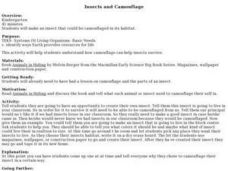Curated OER
Camouflage and Protective Coloration: A Model of Natural Selection
Students investigate natural selection and differential survival among divergent phenotypes of a population. Using everyday items , they model adaptations of camouflage and protective coloration in two very different environments.They...
Curated OER
Animals Abound
Young scholars explore the world of mammals, birds, and fish to compare and contrast their habitats, adaptations, and camouflages. Through research, musical experiences, and hands-on activities, the lives and adventures of these animals...
Curated OER
Where are all the Animals?
Students view animals that camouflage at the Shedd aquarium website. In this camouflage lesson, students recognize that there are different types of camouflage, cryptic coloring, counter-shading, warning coloration and mimicry. Students...
Curated OER
Where in the Wild?
Students investigate the purpose of animals' ability to camouflage. In this animal science lesson, students read the text Where in the Wild? and identify animals that are predators and prey. Students discuss how camouflage is necessary...
Curated OER
Uniform Design
Students investigate the military by examining their uniforms. For this design lesson, students analyze the military uniforms from different locations and time periods. Students create new ideas for current military uniforms.
California Academy of Science
Colorful Fish Adaptations
I love lessons that incorporate the arts, they're so engaging and address a more diverse set of learners. Your class will investigate the reasons fish from the coal reef have adapted such colorful fins. They design a fish that uses color...
Curated OER
Rainforest Animals – Camouflage and Coloring for Protection
Learners explain why animals need to blend in with their surrounding. In this environmental science lesson, students create moth paper models to simulate animals hidden in the rainforests. They make a bulletin board display about what...
Curated OER
Hide In Plain Sight
Students view video clips and use the Internet to look for hidden animals. They then use the Internet to print out animal shapes and color them. They create environments on construction paper in which their animals can hide.
Curated OER
Colonial Camouflage
Students study Colonial America. Using web given web sites, students research the culture, economics, religious beliefs and political thoughts of Colonial America. They answer questions and discuss their views with the class.
Curated OER
Camouflage and Protective Coloration: A Model of Natural Selection
Students collect data and compare whether protective coloration or camouflage provides better biological fitness in a given environment. They simulate predator prey interactions of two different species and use gene frequencies to...
Curated OER
Introduce Vocabulary: I See Animals Hiding (Arnosky)
Animals are amazing at disguise! Explore the different ways they escape view as scholars learn vocabulary-in-context through Jim Arnosky's book I See Animals Hiding. Prepare pupils to raise their hands when they hear the words by...
Project Oceanography
Fish Shape
A fish's size, fins, and shape can tell us a lot about them! Learners explore fish anatomy to see how species use camouflage, scales, shape, and coloration to survive. The lesson includes advanced vocabulary such as fusiform shape,...
Curated OER
Disguise! Disguise!
Third graders explore how some animals disguise or camouflage themselves as a form of protection.
Curated OER
Froggy Fun
Students exploring about frogs and their environment. They describe what camouflage is and why it is useful to frogs especially in the environment that frogs live in. They also draw a picture of a frog in its habitat.
Curated OER
Catch Me if You Can
Third graders investigate behavioral and physical adaptations, such as camouflage, that allow animals to respond to life needs.
Curated OER
Dull Duck, Dashing Duck
Learners learn about animal camouflage. In this animal adaptations lesson, students discuss the patterns and adaptations animals use to help them survive, discuss the uses of camouflage, visit a local wetland if possible, and design...
Curated OER
Animal Hide and Seek
Students read about animal camouflage. In this animal adaptation lesson, students read short texts about ways in which animals hide or transform to escape their prey. Students explore animal classifications and determine ways to hide in...
Curated OER
The Great Jellybean Hunt
Students explore natural selection and its influence on the populations to fine tune traits and characteristics. The acquisition of traits developed out of need is examined through a game played in class.
Curated OER
Orienteering
Students acquaint with co-participants and identify the practice basic compass functions and orienteering procedures. They also work together to solve a small challenge. Students then identify how the challenge of orienteering relates...
Curated OER
U-G-L-Y? I've Got a Great Alibi
Students create a survey to explore people's perception of beauty. In this biology instructional activity, students explain how an animal's appearance helps it survive. They analyze survey results and present findings in class.
Curated OER
Insects and Camouflage
Students create an insect that can be camouflaged in its habitat. They study how camouflage can help insects survive.
Curated OER
Following Directions - Ndakinna Wilderness Project
Students draw a diagram of the steps used to camouflage a person. In this biology lesson, students watch and take notes on a video about using camouflage as a tool to observe nature. Then students follow instructions to create a diagram...
Curated OER
Camouflage in Animal Habitats
Pupils investigate how animals in an ecosystem interact with a nonliving environment through camouflage. They work in cooperative groups to "go fishing" and record how many of each color of fish they "catch." After entering data on a...
Curated OER
A Day in the life of...
Learners read about and study insects--their distinguishing characteristics, habitats, camouflage methods, defense mechanisms, etc. They draw pictures and write a story from the viewpoint of an insect and share their pictures and stories...
Other popular searches
- Animal Camouflage
- Butterflies and Camouflage
- Camouflage and Mimicry
- Camouflage and Art
- Biology Camouflage
- Camouflage by Animals
- Camouflage Mimicry
- Camouflage Lessons
- Camouflage in the Ocean
- Powerpoint Animal Camouflage
- Camouflage Moths
- Animal Camouflage Adaptation

























